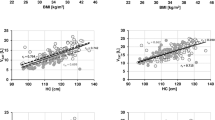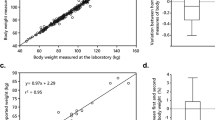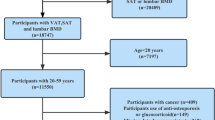Abstract
Background:
On the basis of our previous study, which examined the nonlinear relationship between visceral fat area (VFA) and percent regional fat mass in the trunk, we hypothesise the presence of some storage capacity of subcutaneous fat. This study aimed to examine the storage capacity of subcutaneous fat on the basis of subcutaneous fat area (SFA) and VFA in 791 Japanese adult males and 563 females.
Methods:
Regression analyses by using SFA as a dependent variable and VFA as an independent variable were performed for each group classified by visceral fat obesity (VO): VO (VFA ⩾100 cm2) and the no-VO (NVO) groups. To statistically identify an optimal critical point for subcutaneous fat accumulation, we changed the cutoff point for the VO group from 50–150 cm2 in 10-cm2 increments and confirmed the significance of the correlation between SFA and VFA for each obesity group, the statistical difference in correlations between NVO and VO groups, and the goodness of fit for the two regression lines using the standard error of estimation values. These analyses were conducted for each sex and age (<65 and ⩾65 years) group.
Results:
The critical point for subcutaneous fat accumulation appears at the following cutoff points of VFA: 130 cm2 in <65-year-old males, 110 cm2 in ⩾65-year-old males and 100 cm2 in both female groups.
Conclusions:
These results suggest the presence of some storage capacity of subcutaneous fat. As a further application, these findings may serve to improve the risk assessment of obesity-related diseases.
This is a preview of subscription content, access via your institution
Access options
Subscribe to this journal
Receive 12 print issues and online access
$259.00 per year
only $21.58 per issue
Buy this article
- Purchase on Springer Link
- Instant access to full article PDF
Prices may be subject to local taxes which are calculated during checkout


Similar content being viewed by others
References
Huffman DM, Barzilai N . Contribution of adipose tissue to health span and longevity. Interdiscip Top Gerontol 2010; 37: 1–19.
McLaughlin TM, Liu T, Yee G, Abbasi F, Lamendola C, Reaven GM et al. Pioglitazone increases the proportion of small cells in human abdominal subcutaneous adipose tissue. Obesity 2010; 18: 926–931.
McLaughlin T, Sherman A, Tsao P, Gonzalez O, Yee G, Lamendola C et al. Enhanced proportion of small adipose cells in insulin-resistant vs insulin-sensitive obese individuals implicates impaired adipogenesis. Diabetologia 2007; 50: 1707–1715.
Danforth E Jr . Failure of adipocyte differentiation causes type II diabetes mellitus? Nat Genet 2000; 26: 13.
Klein S, Fontana L, Young VL, Coggan AR, Kilo C, Patterson BW et al. Absence of an effect of liposuction on insulin action and risk factors for coronary heart disease. N Engl J Med 2004; 350: 2549–2557.
Mohammed BS, Cohen S, Reeds D, Young VL, Klein S . Long-term effects of large-volume liposuction on metabolic risk factors for coronary heart disease. Obesity 2008; 16: 2648–2651.
Ybarra J, Blanco-Vaca F, Fernández S, Castellví A, Bonet R, Palomer X et al. The effects of liposuction removal of subcutaneous abdominal fat on lipid metabolism are independent of insulin sensitivity in normal-overweight individuals. Obes Surg 2008; 18: 408–414.
Busetto L, Bassetto F, Zocchi M, Zuliani F, Nolli ML, Pigozzo S et al. The effects of the surgical removal of subcutaneous adipose tissue on energy expenditure and adipocytokine concentrations in obese women. Nutr Metab Cardiovasc Dis 2008; 18: 112–120.
Kim JY, van de Wall E, Laplante M, Azzara A, Trujillo ME, Hofmann SM et al. Obesity-associated improvements in metabolic profile through expansion of adipose tissue. J Clin Invest 2007; 117: 2621–2637.
Huffman DM, Barzilai N . Role of visceral adipose tissue in aging. Biochim Biophys Acta 2009; 1790: 1117–1123.
Demura S, Sato S . Nonlinear relationships between visceral fat area and percent regional fat mass in the trunk and the lower limbs in Japanese adults. Eur J Clin Nutr 2008; 62: 1395–1404.
Tchoukalova YD, Koutsari C, Karpyak MV, Votruba SB, Wendland E, Jensen MD . Subcutaneous adipocyte size and body fat distribution. Am J Clin Nutr 2008; 87: 56–63.
Sniderman AD, Bhopal R, Prabhakaran D, Sarrafzadegan N, Tchernof A . Why might South Asians be so susceptible to central obesity and its atherogenic consequences? The adipose tissue overflow hypothesis. Int J Epidemiol 2007; 36: 220–225.
Björntorp P, Sjöström L . Number and size of adipose tissue fat cells in relation to metabolism in human obesity. Metabolism 1971; 20: 703–713.
Imbeault P, Lemieux S, Prud'homme D, Tremblay A, Nadeau A, Després JP et al. Relationship of visceral adipose tissue to metabolic risk factors for coronary heart disease: is there a contribution of subcutaneous fat cell hypertrophy? Metabolism 1999; 48: 355–362.
Tchernof A, Belanger C, Morisset AS, Richard C, Mailloux J, Laberge P et al. Regional differences in adipose tissue metabolism in women. Diabetes 2006; 55: 1353–1360.
Yoshizumi T, Nakamura T, Yamane M, Islam AH, Menju M, Yamasaki K et al. Abdominal fat: standardized technique for measurement at CT. Radiology 1999; 211: 283–286.
Examination Committee of Criteria for ‘Obesity Disease’ in Japan; Japan Society for the Study of Obesity. New criteria for ‘obesity disease’ in Japan. Circ J 2002; 66: 987–992.
Björntorp P, Gustafson A, Persson B . Adipose tissue fat cell size and number in relation to metabolism in endogenous hypertriglyceridemia. Acta Med Scand 1971; 190: 363–367.
Salans LB, Cushman SW, Weismann RE . Studies of human adipose tissue. J Clin Invest 1973; 52: 929–941.
Rolfe Ede L, Loos RJ, Druet C, Stolk RP, Ekelund U, Griffin SJ et al. Association between birth weight and visceral fat in adults. Am J Clin Nutr 2010; 92: 347–352.
Fujimoto WY, Bergstrom RW, Boyko EJ, Leonetti DL, Newell-Morris LL, Wahl PW . Susceptibility to development of central adiposity among populations. Obes Res 1995; 3: 179S–186S.
Yano K, MacLean CJ, Reed DM, Shimizu Y, Sasaki H, Kodama K et al. A comparison of the 12-year mortality and predictive factors of coronary heart disease among Japanese men in Japan and Hawaii. Am J Epidemiol 1988; 127: 476–487.
Egusa G, Murakami F, Ito C, Matsumoto Y, Kado S, Okamura M et al. Westernized food habits and concentrations of serum lipids in the Japanese. Atherosclerosis 1993; 100: 249–255.
Acknowledgements
This research was supported by JSPS KAKENHI Grant Number 23700847 and by Warani Medical Corporation, Hoju Memorial Hospital (Midorigaoka, Nomi, Ishikawa, Japan, URL http://www.houju.or.jp). The authors would like to thank Enago (www.enago.jp) for the English language review.
Author information
Authors and Affiliations
Corresponding author
Ethics declarations
Competing interests
The authors declare no conflict of interest.
Rights and permissions
About this article
Cite this article
Sato, S., Demura, S. & Nakai, M. Storage capacity of subcutaneous fat in Japanese adults. Eur J Clin Nutr 69, 933–938 (2015). https://doi.org/10.1038/ejcn.2014.292
Received:
Revised:
Accepted:
Published:
Issue Date:
DOI: https://doi.org/10.1038/ejcn.2014.292



